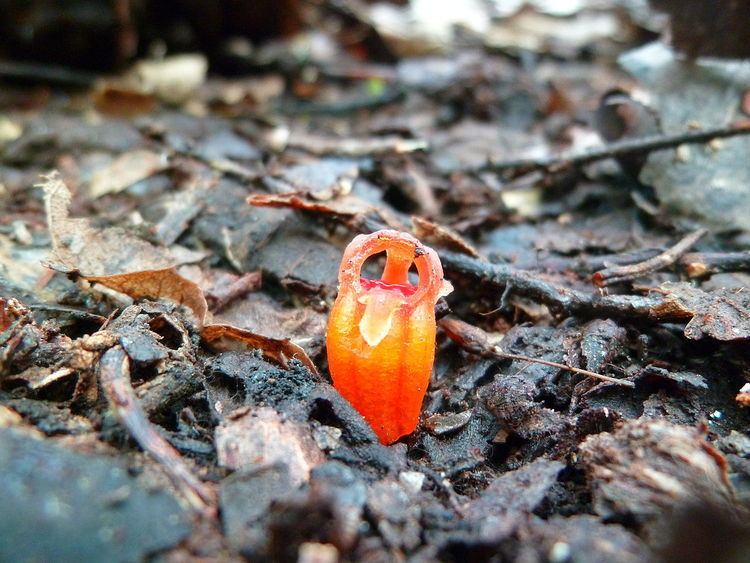Rank Species | ||
 | ||
Similar Thismia, Thismiaceae, Thismia americana, Burmanniaceae, Olearia argophylla | ||
Thismia rodwayi, or fairy lantern, is a non-chlorophyllous plant belonging to the Burmanniaceae family. They are found in the southern states of Australia (Tasmania, Victoria and New South Wales) and in a few places in New Zealand.
Contents
The small number of known individuals of this species has put it under Schedule 5 (Rare) of the Tasmanian Threatened Species Protection Act 1995. However, it is not considered threatened by the International Union for Conservation of Nature (IUCN).
Biology
Thismia rodwayi can be seen as a small reddish-yellowish flower — the lantern — seemingly without stem and leaves. It most often pops out of the forest floor or is hidden under the litter. As it does not contain any chlorophyll, its only vegetative parts are a flower stalk and roots, both devoid of chlorophyll.
It is generally considered saprophytic, even though it is actually associated with a fungus which is the true saprophyte. Its whole life cycle, and especially its reproductive one, is still mostly unknown.
Description
Thismia rodwayi is, as botanist Mark Wapstra puts it, 'aptly described' by its common name: fairy lantern. It is a very small flower, only visible as an orange and red obovate floral tube of 10 to 18 mm in length. This 'flower' is surmounted by six perianth lobes: three inner lobes curving inward, and three outer ones spreading outward.
The flower is at the top of a 0.5 to 3 cm long colourless and subterranean flower stem which sports six bracts increasing in size toward the flower. The flower stem emerges from the 1 to 1.5 mm thick and 4 to 15 cm long roots.
Each individual usually sports only one flower, sometimes two, and they can be found in groups of 2 to 5 plants (but up to 12) in an area of less than 1 m2.
Autecology
Thismia rodwayi occurs in wet eucalypts forests, mainly Eucalyptus obliqua, E. regnans, E. delegatensis and E. viminalis, between 100 and 650 m above sea level. The potential habitat in Tasmania is estimated with the RFA (Regional Forest Agreement), such as "tall E. obliqua forest" (OT) or "wet E. viminalis forest" (VW). However, as occurrence data for the species are sparse, the potential habitat is much more widespread than the flower itself.
On a local scale, potential Thismia areas are identified by a sparse canopy cover, and a damp, dense and cohesive topsoil with a thick litterfall.
Biological life cycle
Thismia rodwayi's life cycle is still very poorly understood. As they usually appear in clumps of near-situated individuals, it is generally accepted that both pollen and seeds are transported only short distances, which could explain why the plant only occurs in a fraction of its potential habitat.
There currently exist two main hypothesis concerning the mechanisms of Thismia rodwayi's pollination:
Vegetative expansion by stolons is also considered a possibility.
Saprophytism
Although widely called a saprophyte, Thismia rodwayi is actually a non-chlorophyllous plant associated with a truly saprophytic fungus. The fungal hypha are found in the cortical cells of the plant's roots, and also around those roots, mixed with humus.
Rotting organic material is absorbed by the fungus and stocked as fat globules in hyphal bladders. The fungal cells are then digested by the host, and the fat globules are turned into a polysaccharide, possibly glycogen.
Rarity and protection
Because of the anecdotal occurrence data concerning this plant, Thismia rodwayi is not listed by the IUCN. It is, however, listed on Schedule 5 (Rare) of the Tasmanian Threatened Species Protection Act 1995 under criterion B (species subject to stochastic risk of endangerment because of naturally small population sizes).
One of the main difficulties to obtaining new data is the cryptic nature of the plant: although brightly coloured, it is often covered by litterfall, and non-specific botanical surveys have a high probability of missing them. Specific surveys however have been successful in detecting Thismia rodwayi, and the amount of data is increasing.
Although most potential habitat zones are protected (either because they are located in national parks, riparian reserves or other protected areas), it seems that Thismia rodwayi is not negatively impacted by normal native forest silvicultural operations such as clearfelling, selective cutting, or even regeneration burning. On the other hand, a change to monospecific plantations would probably be deleterious to the plant.
